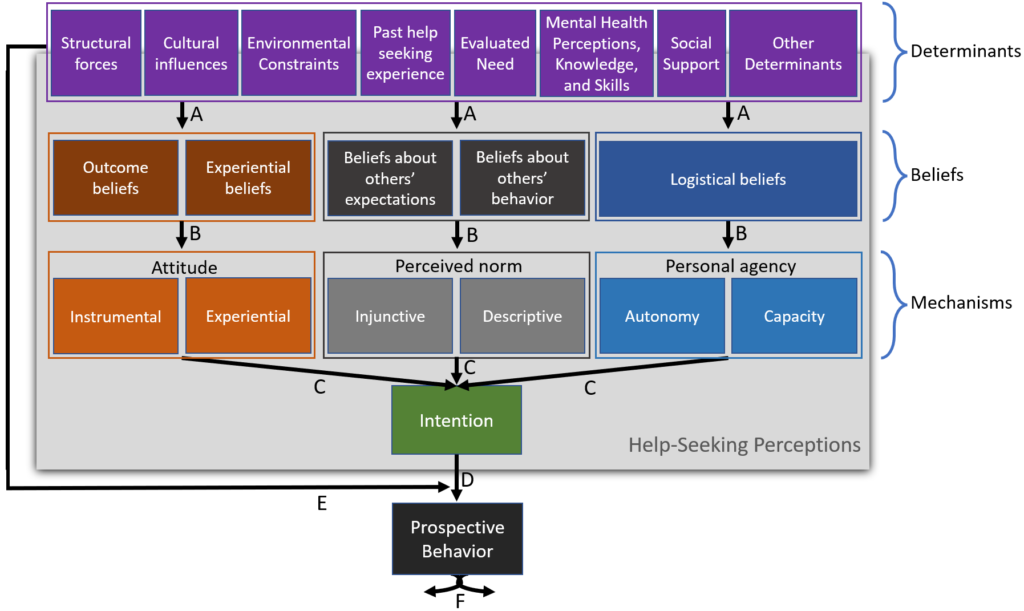As noted on the Theory landing page, the Integrated Behavioral Model of Mental Health Help Seeking (IBM-HS) is a theoretical model for understanding the constructs that influence people’s decision-making around seeking professional mental health care and their ultimate access to mental health treatment.
To learn more about the need for the IBM-HS, visit the IBM-HS Rationale page.
The IBM-HS was designed to identify the causal sequence of constructs that influence mental health help-seeking behavior (see figure below). To learn more about each construct, click on the hyperlinked name of the construct in the paragraph below the figure.

Help-seeking determinants influence help-seeking beliefs (paths marked with “A”), which in turn determine their respective help-seeking mechanisms (“B” paths). These mechanisms collectively influence help-seeking intention (“C” paths). Intention drives prospective help-seeking behavior (“D” path), subject to the moderating effects of help-seeking determinants (“E” path). Lastly, prospective behavior has reciprocal feedback loop effects (“F” paths) on certain determinants (e.g., mental health perceptions, knowledge, and skills) and beliefs. Help-seeking perceptions (contained within the light gray shaded box) are IBM-HS’ suggested term for constructs that operationalize people’s thoughts about help seeking, inclusive of intention, mechanisms, beliefs, and certain aspects of select determinants.
To learn more about the nature and definition of these constructs, visit the Constructs page.
For an overview of available options for measuring each construct, visit the Measures page.
For a review of important IBM-HS measurement guidelines, visit the IBM-HS Measurement Guidelines page.
Per Hammer and colleagues (2024), the most common way to use the IBM-HS is as a theoretical model to ground conceptualization, measurement, and causal sequencing of the constructs that shape help seeking. However, the most robust way to use the IBH-HS is to follow a mixed-method protocol to systematically identify the primary help-seeking beliefs (i.e., the subset of salient beliefs that most distinguish those who intend to seek help from those who do not) of a population and relevant sociodemographic groups therein. For detailed advice on applying the IBM-HS, visit the IBM-HS Applications page.
As the common aphorism goes, “all models are wrong, but some are useful” (Skogen et al., 2021). This holds true for the IBM-HS. To learn more about the current strengths and limits of the IBM-HS, visit the IBM-HS Limitations page.
In summary, the IBM-HS offers guidance to both scholarly and applied professionals who want to understand and eliminate the pervasive behavioral healthcare treatment gaps that exist for many structurally marginalized and underserved populations
If you have questions about the IBM-HS that cannot be answered by the information provided in this website, including our IBM-HS Frequently Asked Questions page, please contact Dr. Joseph Hammer.
(Note: select page content excerpted from Hammer et al., 2024.)